Franche-Comte Property Guide
Franche-Comté means “free county”, and used to be the Free County of Burgundy, to distinguish it from The Duchy of Burgundy next door. If I understand correctly (which is always debatable,) the rulers of Burgundy found it useful to divide the kingdom whenever they had two sons, so each could have a bit. The name Franche-Comté first appears in 1366, and the region has so far resisted proposals by Norman (see our guide to Centre) to re-name it The Bit Near Switzerland Half Way Up The Right Hand Side.
The region was christianised in the sixth century by St Colombanus. Columbanus was an Irishman and was born in Nobber, County Meath. It may even have been Columbanus himself who composed “I love Nobber in the Springtime” and “Nobber, Nobber, it’s a Wonderful Town”. He was ridiculously good-looking (‘Colum Ban’ means ‘handsome Colum’,) and his perfect bone-structure exposed him daily to the shameless advances of local women. Yeah, I get that… Columbanus sought advice from a “religious woman”, who must have been truly religious, because, rather than recommending regular weekly counselling sessions, she told him to flee from almost-certain temptation and take the Holy Word to Franche-Comté. He did so, and today you can visit Luxeuil Abbey, which he founded in 590. Many miracles are attributed to Columbanus, including persuading a bear to excavate his cave. Quite how he persuaded the bear is not recorded. Of course, it may have been a female bear, in which case, she probably offered to lay his patio as well.
Besançon is the region’s capital and its 4th division football club is bizarrely called Besançon Racing Club. This may explain why it plays in the 4th division. Besançon is famous for producing status-symbol quartz watches and automatic ticketing machines for airport car parks. Think of Besançon next time you reach uncomfortably from your car window and drop your ticket in a puddle. The city’s famous sons include the Lumière brothers (see our guide to Provence,) Victor Hugo and Raymond Blanc.
Victor Hugo is best known for writing Les Miserables and The Hunchback of Notre Dame, which, as a stage musical and a Disney film, have gone on to generate millions in theatre revenue and sales of cuddly hunchback toys. Hugo also enjoyed merchandise spin-off success in his own lifetime, with the publication of Toilers of the Sea. Until his sea-creature novel came out, most French believed that the squid was a mythical beast. Now Paris was gripped by squid fever and the 1866 Society Season was a-slither with squid parties, squid exhibitions, squid dishes and squid hats.
Raymond Blanc probably knows what to do with a squid. Disappointingly though, he came last in the Omelette Challenge in BBC’s Saturday Kitchen. Blanc dithered for minutes over his omelette, whilst Jun Tanaka had his on-the-plate and covered in ketchup in just 17 seconds. The 1994 Japanese attempt at world’s largest omelette probably took even longer to cook than Blanc’s. The Japanese chefs then had to eat the 160,000-egg omelette whilst live hamsters were inserted in their underpants. Probably.
© 2008 richardheacock @ mac.com
Franche-Comte Location
Franche-Comte is located on the eastern side on France adjacent to Switzerland with Lake Geneva at the southern tip. Bounded by Rhone-Alpes, Burgundy, Champagne-Ardenne, Lorraine and Alsace. The departments of the region are Doubs, Haute-Saône, Jura, Territoire de Belfort.
Franche-Comte Landscape
Here you can discover wide open spaces and freedom – forests, mountains and valleys, lakes (in fact, 24 large lakes plus a myriad of smaller ones) and a vast network of rivers; From the historical perspective, numerous monuments and sites of exceptional interest.
Franche-Comte Attractions
Franche-Comte is well known for its Gruyère cheese, cross-country skiing in winter and for canoeing and hiking in summer in the beautiful Jura mountain range.
Besançon has a reputation for innovation in industries as diverse as optics, electronics, acoustics, climate control and automation. There are many science parks in the area. It is a former centre of watch-making excellence.
Among the attractions of Territoire de Belfort is the Lion de Belfort statue by Bartoldi (the sculptor of New York’s Statue of Liberty).
Franche-Comte Weather
Winters tend to be quite cold and very similar to those in the UK. Summer is relatively hot and sunny!
Getting there
Air Travel
Air France offers London-Heathrow direct to Lyon
British Airways runs services from London to Lyon and Geneva
Easyjet offers flights from Luton to Geneva.
By Train
TGV trains from Paris-Gare de Lyon to Besançon, Lyon and Grenoble During the ski season there is a direct Eurostar service (www.eurostar.co.uk) from London-Waterloo (or Ashford) through to Bourg-Saint-Maurice.
By Road
Good autoroute access to Dijon and then change onto the autoroute to Besançon.
Franche-Comte population
1.1 million inhabitants.
Major Towns/Cities
The principal cities are Besançon (the historical and the modern capital of the region), Belfort, and Montbéliard. Other important cities are Dole (previous capital before the region was conquered by Louis XIV in the late 17th century), Vesoul (capital of Haute-Saône), Arbois (the “wine capital” of the Jura), and Lons-le-Saunier (capital of Jura).
Franche-Comte Prices
The major towns are more expensive but rural locations can be cheap! So shop around.
Price Guideline
Apartments: 100,000 + euros (major towns)
Farmhouses: 25,000 euros (needs renovation)
Townhouses: 120,000 euros
Land: from 9 euros per sq. m
Franche-Comte Property Selection
Listed below are the departments in the region of Franche-Comte; the number of properties in each department are denoted in brackets - click on a department to see the properties available.All the properties in Franche-Comte by department.
(Number in brackets = number of properties)
